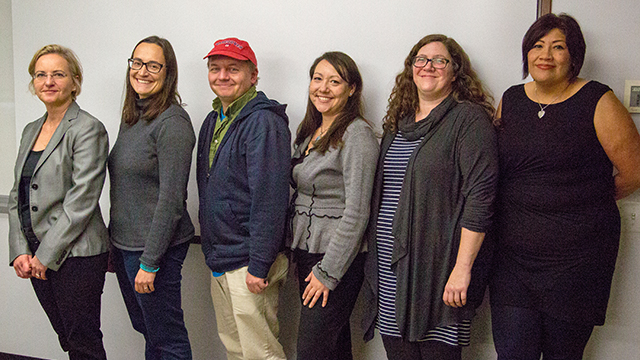
Indigenous Community Engagement, Research, and Learning Scholars From Left to Right: Priscilla Ferrazzi, Ania Ulrich, Jordan Lachler, Shalene Jobin, Hadley Friedland and Kim TallBear
Indigenous people and communities are coming together with UAlberta professors and graduate students in the pursuit of knowledge and the willingness to learn from each other. The Faculty of Graduate Studies and Research (FGSR) is making it happen through six research projects funded by the Indigenous Community Engagement, Research and Learning (CERL) Grants, each valued at $50,000 for a two-year term.
"This project represents a commitment to multidisciplinary research, inclusiveness in the academy, design of outstanding learning experiences for our students, and a response specifically to the Indigenous community around us," said Suzanne Kresta, Associate Dean, FGSR, at the launch event on Oct. 28. Kresta and Bryan Hogeveen Associate Dean, FGSR led the committee that selected the six projects from the original 22 applications. The decisions were made with input from multiple faculties, staff and students.
The inclusion of Indigenous people and communities in the research process, as well as the union and co-production of different types of knowledge, are common to all of the projects, one of which has already been received with great enthusiasm.
"Before we even had our first official meeting, the community people took initiative and gave guidance and lots of incredible ideas," said University of Alberta Faculty of Law Visiting Assistant Professor Hadley Friedland.
Friedland and Faculty of Native Studies Associate Professor and Aboriginal Governance Director Shalene Jobin aim to get out of the classroom and onto the land with "The ᐊᐧ ᐦ ᑯᐦ ᑐᐃᐧ ᐣ Wahkohtowin Project: Pedagogy and Practice Through Community and Academic Indigenous-Based Learning Collaborations."
UAlberta professors and Cree Elders will teach 12 students ways to respectfully and productively engage with Cree legal traditions and governance principles like Wahkohtowin, which translates approximately as our inter-relatedness and interdependence. Students will learn through a number of activities, including lectures, storytelling, nature walks, raising a teepee and - the traditional brain tanning of a moose hide.
"The day that we submitted (the proposal), some of the community members, some of the elders, the women, they were down by the river in the community tanning hides and they have a smokehouse, so they sent us pictures about how they're excited to bring students there and teach them about it," Jobin noted.
The other research projects are:
Reciprocal Inuit/Graduate Student Research Training in the Canadian Arctic: Workshops and a Film
Priscilla Ferrazzi, Assistant Professor, Faculty of Rehabilitation Medicine
Priscilla Ferrazzi's project seeks to combine western qualitative research with Inuit approaches to the same research questions. Her project will provide a forum for the discussion of these different approaches. "The project will create a training program that's intended to improve the research capacity in indigenous communities, and in particular, Inuit communities," Ferrazzi said.
Indigenous Knowledge Mobilization
Rebecca Sockbeson, Assistant Professor, Educational Policy Studies
Rebecca Sockbeson's project addresses how Indigenous graduate and undergraduate students can access their own ancestral ways of knowing and being. "The knowledge that comes out of this research will enhance public information and knowledge regarding the historical relationship between Indigenous peoples in Canada, allowing all Canadians to move towards better understanding the systematic dispossession of these ancient and ancestral knowledges," Sarah Cortez said, speaking on behalf of Sockbeson at the launch. "This is a critical time for the academy and Indigenous communities to converge in ways that contribute to redress of the IRS [Indian Residential Schools] legacy."
Responding to the Call: Supporting Indigenous Language Sustainability on Alberta
Jordan Lachler, Assistant Professor, Linguistics
Jordan Lachler's team will partner with four Indigenous communities around Alberta to discuss language needs and develop community language resources to confront the crisis situation many Aboriginal languages face. "All of the community programs have some really immediate, tangible needs in terms of curriculum resources, materials they can use in the school, materials for new adult learners, that we want to address-that we want to partner with them on, as we're having these broader high-level discussions about the role of the university in helping to sustain Indigenous languages," Lachler said.
Indigenous Youth: Future Leaders in STEM Careers
Ania Ulrich, Associate Professor, Civil and Environmental Engineering
Ania Ulrich's project will look at co-producing knowledge with the Indigenous youth community on the Alexis Nakota Sioux First Nation to combat the environmental problem of algal blooms on Lac Ste. Anne, which is the site of an annual pilgrimage for Alexis Nakota Sioux and several other First Nations communities in Alberta. "We believe that if we're really going to effect change and really start to challenge the biases that we're coming into, in engineering-it has to come from the younger generation," she said.
The Establishment of the Indigenous Peoples, Technoscience, and Environment Research and Training Program
Kim TallBear, Associate Professor, Faculty of Native Studies
Kim TallBear's work is aimed at empowering Indigenous peoples to govern themselves through science. Her project will focus on genomics and de-colonial bioethics. She's particularly interested in applying these principles to the study of chronic wasting disease in Alberta. "One of the most common roles for Indigenous peoples in science is as a research object," TallBear said. "Some would say subject but we're quite objectified. This, I would say, is still the majority of research today coming out of the academy."
These projects mark an important step toward collaborative change in response to the calls for action in the Truth and Reconciliation Commission's 2015 final report.